light SATURN SKY 2007 Owner's Manual
[x] Cancel search | Manufacturer: SATURN, Model Year: 2007, Model line: SKY, Model: SATURN SKY 2007Pages: 384, PDF Size: 2.47 MB
Page 98 of 384

OnStar®service cannot work unless your vehicle
is in a place where OnStar®has an agreement
with a wireless service provider for service in
that area. OnStar
®service also cannot work
unless you are in a place where the wireless
service provider OnStar
®has hired for that area
has coverage, network capacity and reception
when the service is needed, and technology
that is compatible with the OnStar
®service.
Not all services are available everywhere,
particularly in remote or enclosed areas, or
at all times.
OnStar
®service that involves location
information about your vehicle cannot work
unless GPS satellite signals are unobstructed
and available in that place as well.Your vehicle must have a working electrical
system (including adequate battery power) for the
OnStar
®equipment to operate. There are other
problems OnStar®cannot control that may prevent
OnStar®from providing OnStar®service to you
at any particular time or place. Some examples are
damage to important parts of your vehicle in an
accident, hills, tall buildings, tunnels, weather
or wireless phone network congestion.
Your Responsibility
You may need to increase the volume of your
radio to hear the OnStar®advisor. If the light next
to the OnStar®buttons is red, this means that
your system is not functioning properly and should
be checked by a dealer. If the light appears
clear (no light is appearing), your OnStar
®
subscription has expired. You can always press
the OnStar®button to con�rm that your OnStar®
equipment is active.
98
ProCarManuals.com
Page 105 of 384
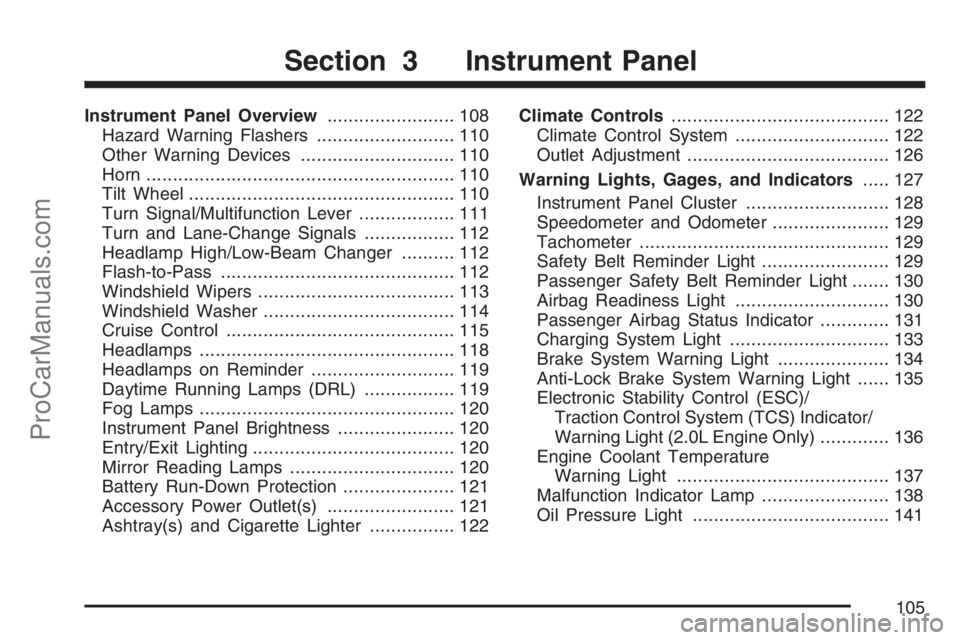
Instrument Panel Overview........................ 108
Hazard Warning Flashers.......................... 110
Other Warning Devices............................. 110
Horn.......................................................... 110
Tilt Wheel.................................................. 110
Turn Signal/Multifunction Lever.................. 111
Turn and Lane-Change Signals................. 112
Headlamp High/Low-Beam Changer.......... 112
Flash-to-Pass............................................ 112
Windshield Wipers..................................... 113
Windshield Washer.................................... 114
Cruise Control........................................... 115
Headlamps................................................ 118
Headlamps on Reminder........................... 119
Daytime Running Lamps (DRL)................. 119
Fog Lamps................................................ 120
Instrument Panel Brightness...................... 120
Entry/Exit Lighting...................................... 120
Mirror Reading Lamps............................... 120
Battery Run-Down Protection..................... 121
Accessory Power Outlet(s)........................ 121
Ashtray(s) and Cigarette Lighter................ 122Climate Controls......................................... 122
Climate Control System............................. 122
Outlet Adjustment...................................... 126
Warning Lights, Gages, and Indicators..... 127
Instrument Panel Cluster........................... 128
Speedometer and Odometer...................... 129
Tachometer............................................... 129
Safety Belt Reminder Light........................ 129
Passenger Safety Belt Reminder Light....... 130
Airbag Readiness Light............................. 130
Passenger Airbag Status Indicator............. 131
Charging System Light.............................. 133
Brake System Warning Light..................... 134
Anti-Lock Brake System Warning Light...... 135
Electronic Stability Control (ESC)/
Traction Control System (TCS) Indicator/
Warning Light (2.0L Engine Only)............. 136
Engine Coolant Temperature
Warning Light........................................ 137
Malfunction Indicator Lamp........................ 138
Oil Pressure Light..................................... 141
Section 3 Instrument Panel
105
ProCarManuals.com
Page 106 of 384
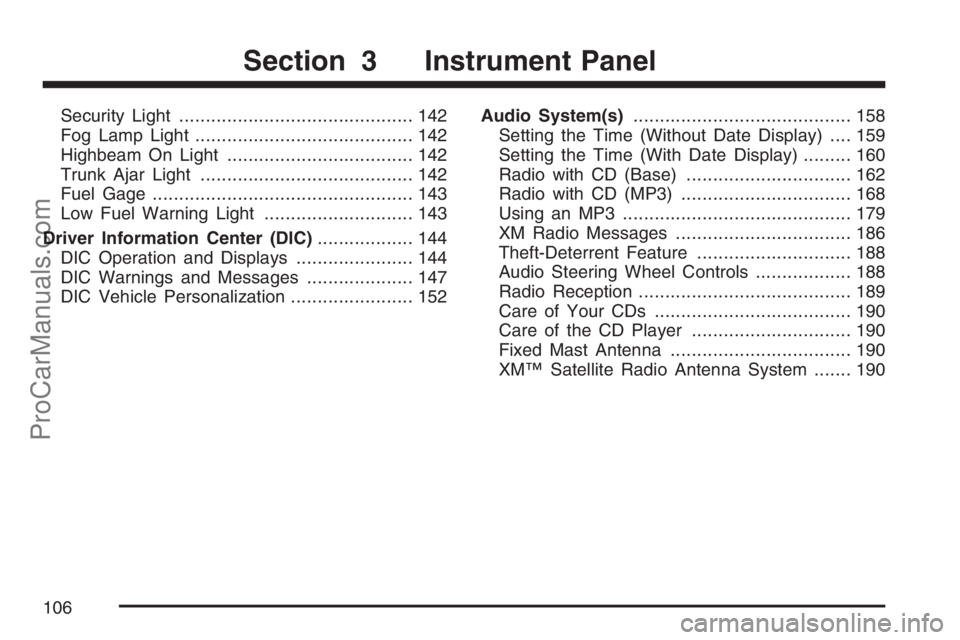
Security Light............................................ 142
Fog Lamp Light......................................... 142
Highbeam On Light................................... 142
Trunk Ajar Light........................................ 142
Fuel Gage................................................. 143
Low Fuel Warning Light............................ 143
Driver Information Center (DIC).................. 144
DIC Operation and Displays...................... 144
DIC Warnings and Messages.................... 147
DIC Vehicle Personalization....................... 152Audio System(s)......................................... 158
Setting the Time (Without Date Display).... 159
Setting the Time (With Date Display)......... 160
Radio with CD (Base)............................... 162
Radio with CD (MP3)................................ 168
Using an MP3........................................... 179
XM Radio Messages................................. 186
Theft-Deterrent Feature............................. 188
Audio Steering Wheel Controls.................. 188
Radio Reception........................................ 189
Care of Your CDs..................................... 190
Care of the CD Player.............................. 190
Fixed Mast Antenna.................................. 190
XM™ Satellite Radio Antenna System....... 190
Section 3 Instrument Panel
106
ProCarManuals.com
Page 109 of 384

The main components of your instrument panel are the following:
A. Side Window Outlets. SeeClimate Control
System on page 122.
B. Air Outlets. SeeOutlet Adjustment on page 126.
C. Turn Signal/Multifunction Lever. SeeTurn
Signal/Multifunction Lever on page 111.
D. Cruise Control Buttons (If Equipped).
SeeCruise Control on page 115.
E. Instrument Panel Cluster. SeeInstrument
Panel Cluster on page 128.
F. Audio Steering Wheel Controls (If Equipped).
SeeAudio Steering Wheel Controls on
page 188.
G. Hazard Warning Flashers Button. SeeHazard
Warning Flashers on page 110.
H. Fog Lamp Button. SeeFog Lamps on page 120.
I. Instrument Panel Brightness Control. See
Instrument Panel Brightness on page 120.
J. Driver Information Center (DIC) Controls. See
Driver Information Center (DIC) on page 144.
K. Horn. SeeHorn on page 110.
L. Windshield Wiper/Washer Controls. See
Windshield Wipers on page 113and
Windshield Washer on page 114.M. Climate Controls. SeeClimate Control System
on page 122.
N. Passenger Air Bag Status Indicator. See
Passenger Airbag Status Indicator on page 131.
O. Shift Lever. SeeManual Transmission
Operation on page 85. SeeAutomatic
Transmission Operation on page 82
(If Equipped).
P. Parking Brake Lever. SeeParking Brake
on page 86.
Q. Audio System. SeeAudio System(s) on
page 158.
R. Electronic Stability Control/Traction Control
System Button. SeeElectronic Stability Control
on page 201.
S. Cigarette Lighter (If Equipped). Accessory
Power Outlet (If Equipped). SeeAshtray(s) and
Cigarette Lighter on page 122andAccessory
Power Outlet(s) on page 121.
T. Cupholder. SeeCupholder(s) on page 99.
U. Trunk Release. SeeTrunk on page 68.
V. Glove Box. SeeGlove Box on page 99.
109
ProCarManuals.com
Page 112 of 384
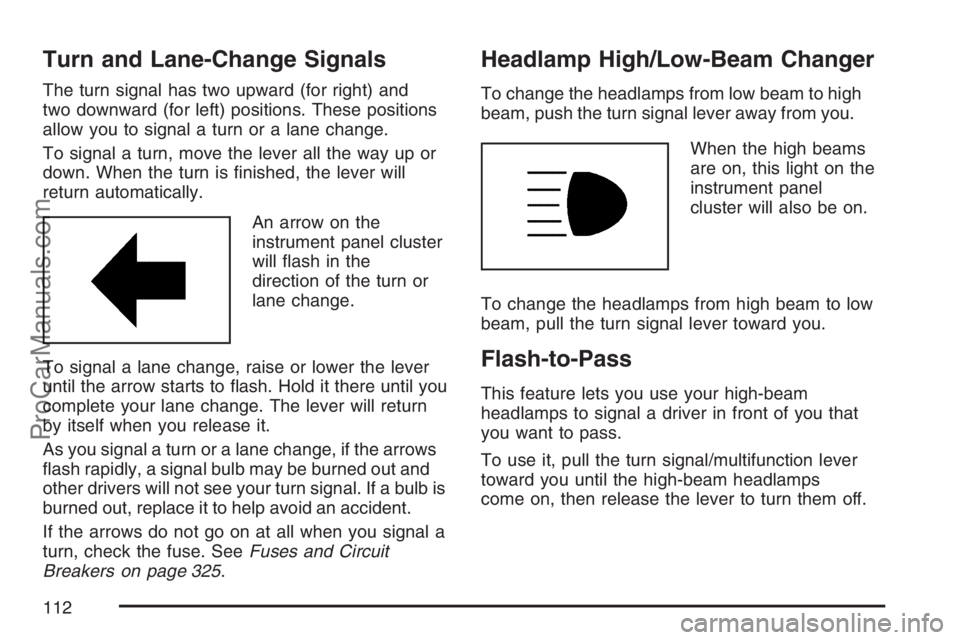
Turn and Lane-Change Signals
The turn signal has two upward (for right) and
two downward (for left) positions. These positions
allow you to signal a turn or a lane change.
To signal a turn, move the lever all the way up or
down. When the turn is �nished, the lever will
return automatically.
An arrow on the
instrument panel cluster
will �ash in the
direction of the turn or
lane change.
To signal a lane change, raise or lower the lever
until the arrow starts to �ash. Hold it there until you
complete your lane change. The lever will return
by itself when you release it.
As you signal a turn or a lane change, if the arrows
�ash rapidly, a signal bulb may be burned out and
other drivers will not see your turn signal. If a bulb is
burned out, replace it to help avoid an accident.
If the arrows do not go on at all when you signal a
turn, check the fuse. SeeFuses and Circuit
Breakers on page 325.
Headlamp High/Low-Beam Changer
To change the headlamps from low beam to high
beam, push the turn signal lever away from you.
When the high beams
are on, this light on the
instrument panel
cluster will also be on.
To change the headlamps from high beam to low
beam, pull the turn signal lever toward you.
Flash-to-Pass
This feature lets you use your high-beam
headlamps to signal a driver in front of you that
you want to pass.
To use it, pull the turn signal/multifunction lever
toward you until the high-beam headlamps
come on, then release the lever to turn them off.
112
ProCarManuals.com
Page 115 of 384

Cruise Control
With cruise control, your vehicle can maintain a
speed of about 25 mph (40 km/h) or more without
keeping your foot on the accelerator. This can
really help on long trips. Cruise control does not
work at speeds below 25 mph (40 km/h).
{CAUTION:
Cruise control can be dangerous where
you cannot drive safely at a steady speed.
So, do not use your cruise control on
winding roads or in heavy traffic.
Cruise control can be dangerous on
slippery roads. On such roads, fast
changes in tire traction can cause
excessive wheel slip, and you could lose
control. Do not use cruise control on
slippery roads.
Setting Cruise Control
{CAUTION:
If you leave your cruise control on when
you are not using cruise, you might hit a
button and go into cruise when you do not
want to. You could be startled and even
lose control. Keep the cruise control switch
off until you want to use cruise control.
The cruise control
buttons are located on
the left side of the
steering wheel.
J(On/Off):Press this button to turn the cruise
control system on and off. The LED indicator light
will turn on and off when this button is pressed.
115
ProCarManuals.com
Page 116 of 384
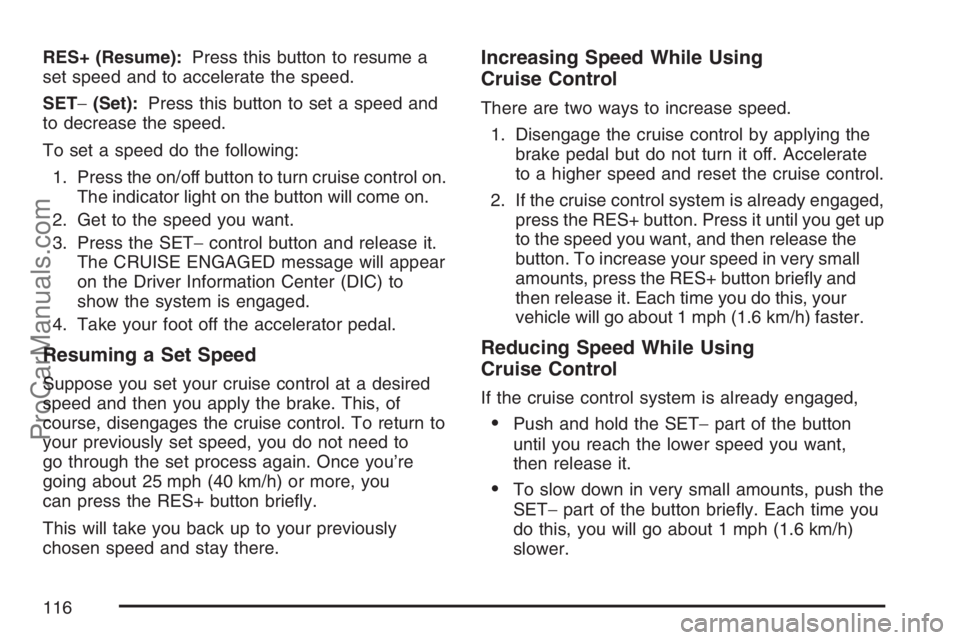
RES+ (Resume):Press this button to resume a
set speed and to accelerate the speed.
SET−(Set):Press this button to set a speed and
to decrease the speed.
To set a speed do the following:
1. Press the on/off button to turn cruise control on.
The indicator light on the button will come on.
2. Get to the speed you want.
3. Press the SET−control button and release it.
The CRUISE ENGAGED message will appear
on the Driver Information Center (DIC) to
show the system is engaged.
4. Take your foot off the accelerator pedal.
Resuming a Set Speed
Suppose you set your cruise control at a desired
speed and then you apply the brake. This, of
course, disengages the cruise control. To return to
your previously set speed, you do not need to
go through the set process again. Once you’re
going about 25 mph (40 km/h) or more, you
can press the RES+ button brie�y.
This will take you back up to your previously
chosen speed and stay there.
Increasing Speed While Using
Cruise Control
There are two ways to increase speed.
1. Disengage the cruise control by applying the
brake pedal but do not turn it off. Accelerate
to a higher speed and reset the cruise control.
2. If the cruise control system is already engaged,
press the RES+ button. Press it until you get up
to the speed you want, and then release the
button. To increase your speed in very small
amounts, press the RES+ button brie�y and
then release it. Each time you do this, your
vehicle will go about 1 mph (1.6 km/h) faster.
Reducing Speed While Using
Cruise Control
If the cruise control system is already engaged,
Push and hold the SET−part of the button
until you reach the lower speed you want,
then release it.
To slow down in very small amounts, push the
SET−part of the button brie�y. Each time you
do this, you will go about 1 mph (1.6 km/h)
slower.
116
ProCarManuals.com
Page 117 of 384
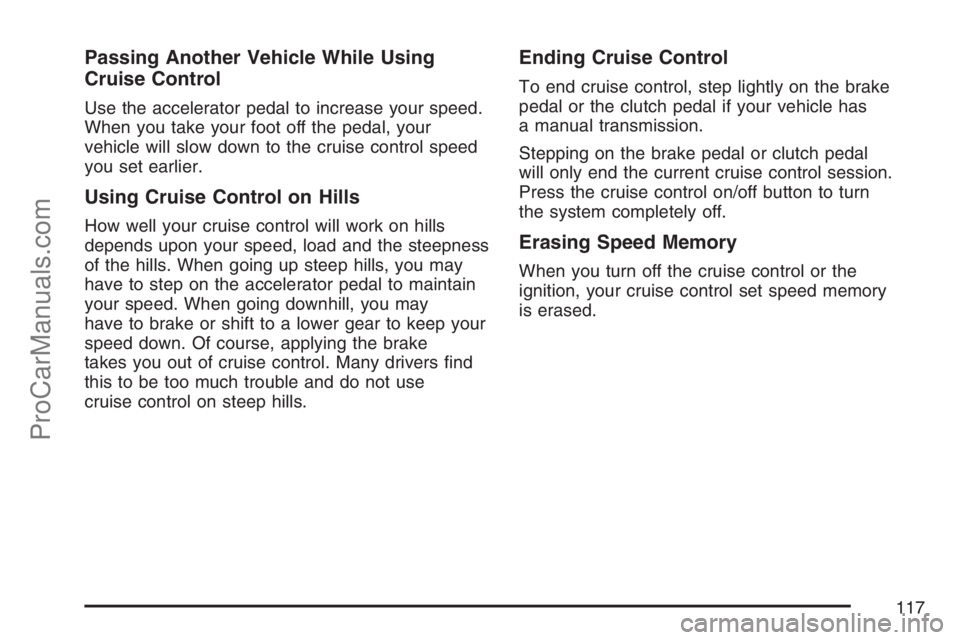
Passing Another Vehicle While Using
Cruise Control
Use the accelerator pedal to increase your speed.
When you take your foot off the pedal, your
vehicle will slow down to the cruise control speed
you set earlier.
Using Cruise Control on Hills
How well your cruise control will work on hills
depends upon your speed, load and the steepness
of the hills. When going up steep hills, you may
have to step on the accelerator pedal to maintain
your speed. When going downhill, you may
have to brake or shift to a lower gear to keep your
speed down. Of course, applying the brake
takes you out of cruise control. Many drivers �nd
this to be too much trouble and do not use
cruise control on steep hills.
Ending Cruise Control
To end cruise control, step lightly on the brake
pedal or the clutch pedal if your vehicle has
a manual transmission.
Stepping on the brake pedal or clutch pedal
will only end the current cruise control session.
Press the cruise control on/off button to turn
the system completely off.
Erasing Speed Memory
When you turn off the cruise control or the
ignition, your cruise control set speed memory
is erased.
117
ProCarManuals.com
Page 118 of 384

Headlamps
The lever on the left side of the steering column
operates the exterior lamps.
The exterior lamp switch has the following
four positions:
2(Headlamps):This position turns on the
headlamps, parking lamps, and taillamps.
;(Parking Lamps):This position turns on the
parking lamps and taillamps only.
AUTO (Automatic Headlamp System):This
position automatically turns on the Daytime
Running Lamps during daytime, and the
headlamps, parking lamps, and taillamps at night.
P(Off/On):This position is an Off/On switch for
the Automatic Headlamp System. In Canada, this
applies to vehicles with an automatic transmission
set to PARK (P) and manual transmission vehicles
with the parking brake engaged.
When operating in AUTO, a brief turn of the switch
to off/on will turn off the Automatic Headlamp
System. An AUTO LIGHTS OFF message will
display on the Driver Information Center (DIC) and
a chime will sound. Turning the switch to off/on
again will turn the Automatic Headlamp System
back on. An AUTO LIGHTS ON message will
display on the Driver Information Center (DIC).
The Automatic Headlamp System is always turned
on at the beginning of an ignition cycle for vehicles
with manual transmission. When the parking brake
is engaged, the automatic headlamps will turn off.
For vehicles with an automatic transmission, when
the shift lever is shifted out of PARK (P), the
Automatic Headlamp System will turn on. Shifting
the lever back to PARK (P) will turn off the
automatic headlamp system for vehicles with an
automatic transmission.
118
ProCarManuals.com
Page 119 of 384

Headlamps on Reminder
If you open the driver’s door with the ignition off
and the lamps on, you will hear a warning chime.
Daytime Running Lamps (DRL)
Daytime Running Lamps (DRL) can make it easier
for others to see the front of your vehicle during
the day. DRL can be helpful in many different
driving conditions, but they can be especially
helpful in the short periods after dawn and before
sunset. Fully functional daytime running lamps
are required on all vehicles �rst sold in Canada.
Your vehicle has a light sensor on top of the
instrument panel that helps control the DRL.
Make sure it is not covered or the headlamps
will come on when they are not needed.
The DRL system makes both low beam headlamps
turn on at reduced intensity when the following
conditions are met:
The ignition is on.
The exterior lamp control is turned to AUTO.
The light sensor detects daytime light.
The shift lever is not in PARK (P).While the DRL system is on, the taillamps,
sidemarker lamps, and instrument panel lights
will not be on.
The DRL system turns off on U.S. vehicles by
using the on/off switch for one ignition cycle,
if the vehicle is in the PARK (P) position, or if the
vehicle speed is less than 5 mph (8 km h)
after the vehicle is started.
For vehicles �rst sold in Canada the DRL system
will turn off when a automatic transmission
vehicle is in the PARK (P) position or the park
brake is set on a manual transmission vehicle and
the vehicle speed is less than 8 mph (13 km h).
As with any vehicle, you should turn on the regular
headlamp system when it is needed.
119
ProCarManuals.com